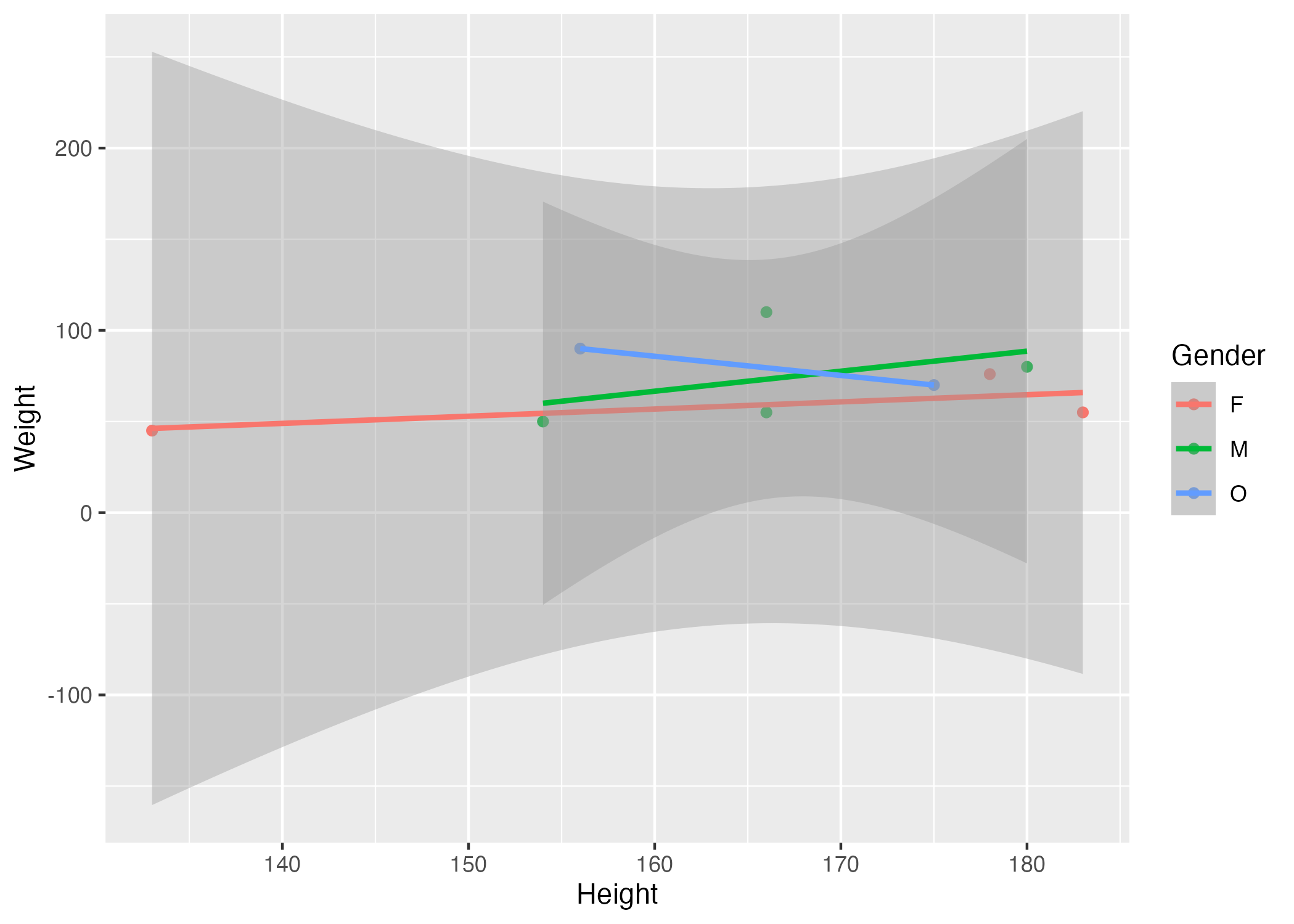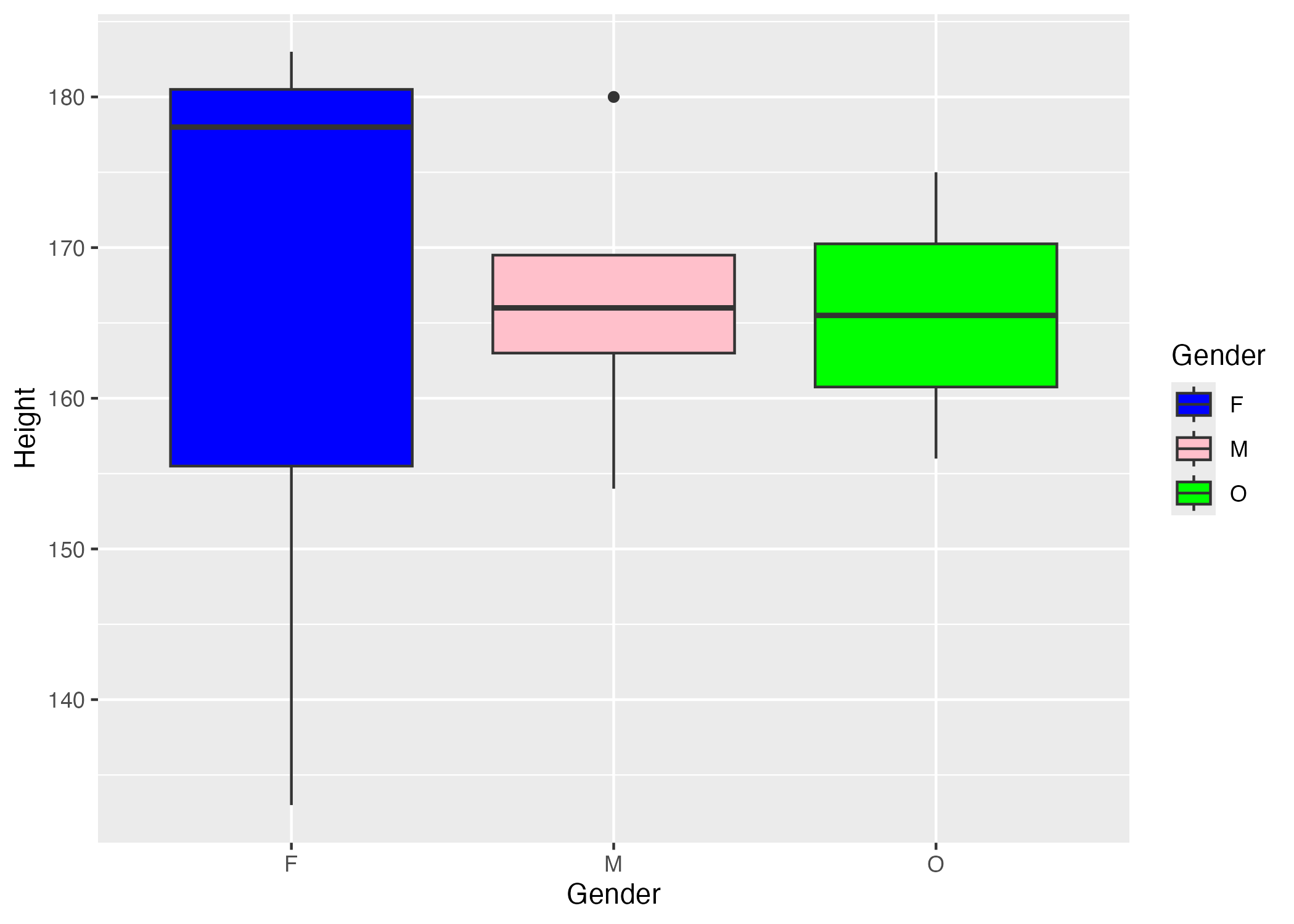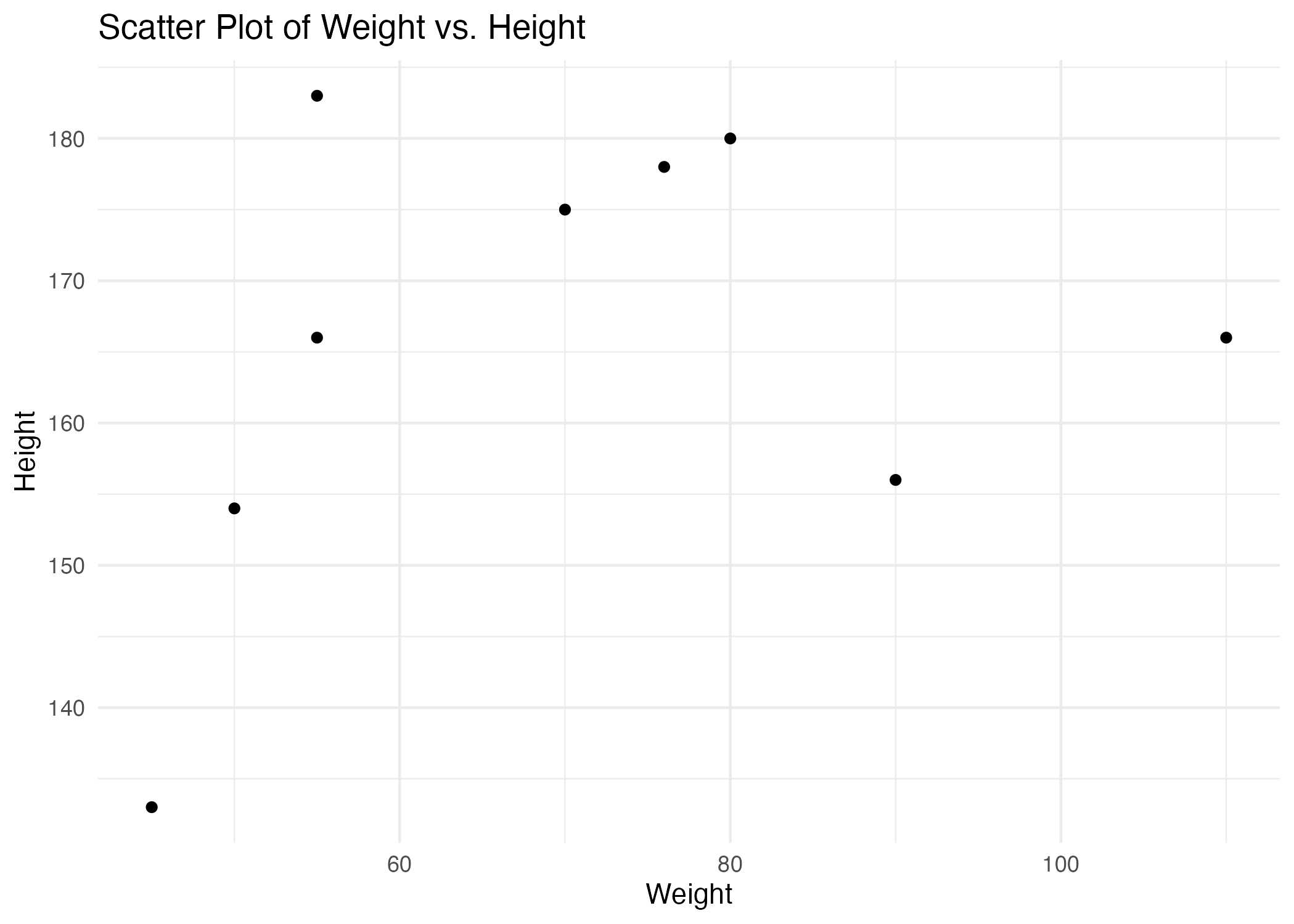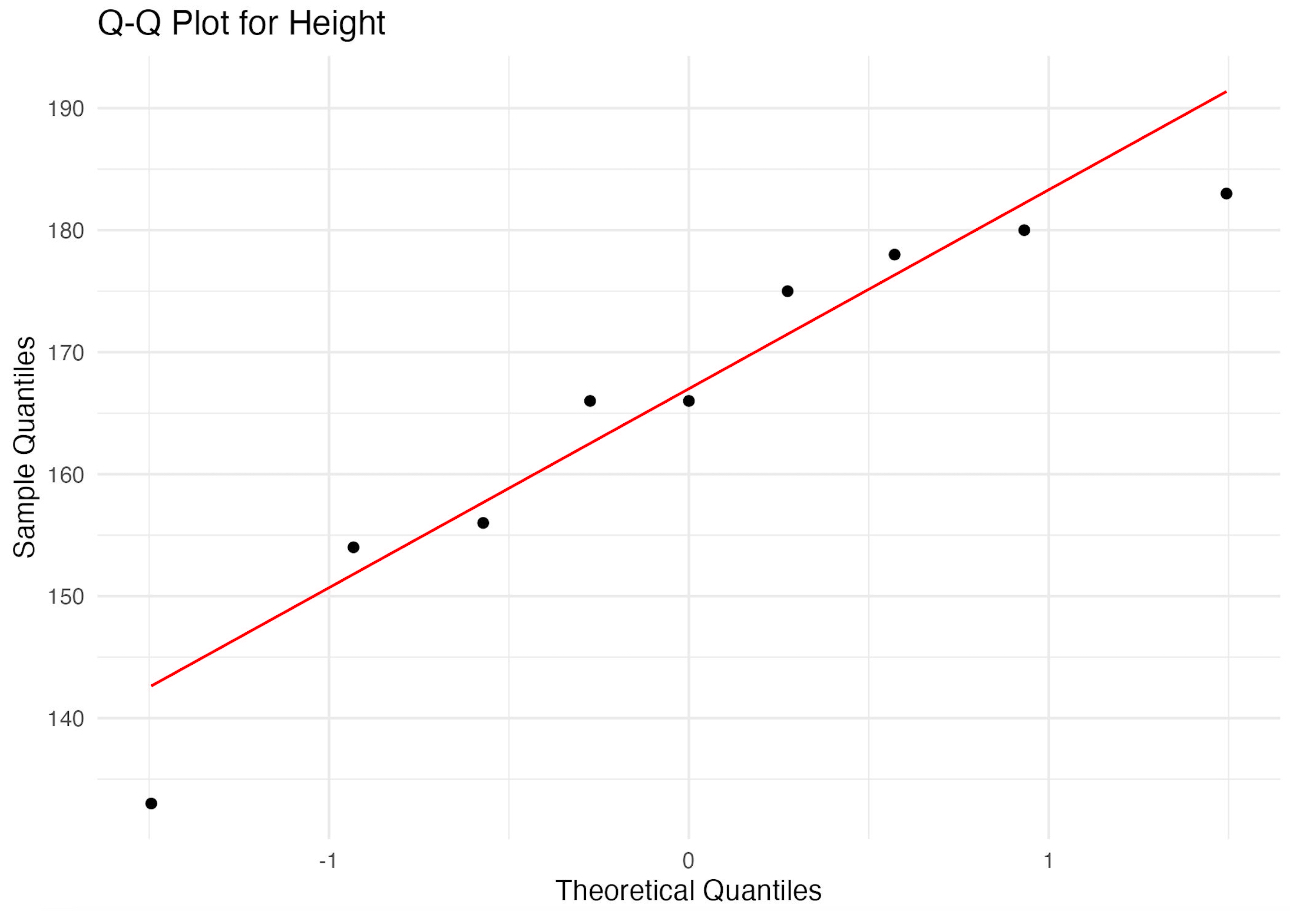| skim_type | skim_variable | n_missing | complete_rate | factor.ordered | factor.n_unique | factor.top_counts | numeric.mean | numeric.sd | numeric.p0 | numeric.p25 | numeric.p50 | numeric.p75 | numeric.p100 | numeric.hist |
|---|---|---|---|---|---|---|---|---|---|---|---|---|---|---|
| factor | Gender | 0 | 1 | FALSE | 3 | M: 4, F: 3, O: 2 | NA | NA | NA | NA | NA | NA | NA | NA |
| numeric | Height | 0 | 1 | NA | NA | NA | 165.66667 | 15.97655 | 133 | 156 | 166 | 178 | 183 | ▂▁▃▃▇ |
| numeric | Weight | 0 | 1 | NA | NA | NA | 70.11111 | 21.24526 | 45 | 55 | 70 | 80 | 110 | ▇▂▃▂▂ |
Manuscript/Report Template for a Data Analysis Project
The structure below is one possible setup for a data analysis project (including the course project). For a manuscript, adjust as needed. You don’t need to have exactly these sections, but the content covering those sections should be addressed.
This uses MS Word as output format. See here for more information. You can switch to other formats, like html or pdf. See the Quarto documentation for other formats.
1 Contributors
Muhammad Nasir contributed to exercise two. Note: After merging, I realized the ProjectID for my Rstudio had somehow been replaced so I had to obtain the old version of my repo and copy and paste Muhammad’s work in.
2 Summary/Abstract
Write a summary of your project.
3 Introduction
3.1 General Background Information
Provide enough background on your topic that others can understand the why and how of your analysis
3.2 Description of data and data source
Describe what the data is, what it contains, where it is from, etc. Eventually this might be part of a methods section. This data is example data created for the MADA course. The variables are: height, weight, gender, age, and hair color. The two variables I added are: age and hair color. Age is any number greater than 0 (years). Hair color fits into one of several categories: black, blonde, brunette, red, or other.
3.3 Questions/Hypotheses to be addressed
State the research questions you plan to answer with this analysis.
To cite other work (important everywhere, but likely happens first in introduction), make sure your references are in the bibtex file specified in the YAML header above (here dataanalysis_template_references.bib) and have the right bibtex key. Then you can include like this:
Examples of reproducible research projects can for instance be found in (McKay, Ebell, Billings, et al., 2020; McKay, Ebell, Dale, Shen, & Handel, 2020)
4 Methods
Describe your methods. That should describe the data, the cleaning processes, and the analysis approaches. You might want to provide a shorter description here and all the details in the supplement.
4.1 Data aquisition
As applicable, explain where and how you got the data. If you directly import the data from an online source, you can combine this section with the next.
4.2 Data import and cleaning
Write code that reads in the file and cleans it so it’s ready for analysis. Since this will be fairly long code for most datasets, it might be a good idea to have it in one or several R scripts. If that is the case, explain here briefly what kind of cleaning/processing you do, and provide more details and well documented code somewhere (e.g. as supplement in a paper). All materials, including files that contain code, should be commented well so everyone can follow along.
4.3 Statistical analysis
Explain anything related to your statistical analyses.
5 Results
5.1 Exploratory/Descriptive analysis
Use a combination of text/tables/figures to explore and describe your data. Show the most important descriptive results here. Additional ones should go in the supplement. Even more can be in the R and Quarto files that are part of your project.
Table 1 shows a summary of the data.
Note the loading of the data providing a relative path using the ../../ notation. (Two dots means a folder up). You never want to specify an absolute path like C:\ahandel\myproject\results\ because if you share this with someone, it won’t work for them since they don’t have that path. You can also use the here R package to create paths. See examples of that below. I recommend the here package, but I’m showing the other approach here just in case you encounter it.
5.2 Basic statistical analysis
To get some further insight into your data, if reasonable you could compute simple statistics (e.g. simple models with 1 predictor) to look for associations between your outcome(s) and each individual predictor variable. Though note that unless you pre-specified the outcome and main exposure, any “p<0.05 means statistical significance” interpretation is not valid.
Figure 1 shows a scatterplot figure produced by one of the R scripts.

5.3 Full analysis
Use one or several suitable statistical/machine learning methods to analyze your data and to produce meaningful figures, tables, etc. This might again be code that is best placed in one or several separate R scripts that need to be well documented. You want the code to produce figures and data ready for display as tables, and save those. Then you load them here.
Example Table 2 shows a summary of a linear model fit.
| term | estimate | std.error | statistic | p.value |
|---|---|---|---|---|
| (Intercept) | 149.2726967 | 23.3823360 | 6.3839942 | 0.0013962 |
| Weight | 0.2623972 | 0.3512436 | 0.7470519 | 0.4886517 |
| GenderM | -2.1244913 | 15.5488953 | -0.1366329 | 0.8966520 |
| GenderO | -4.7644739 | 19.0114155 | -0.2506112 | 0.8120871 |
6 Discussion
6.1 Summary and Interpretation
Summarize what you did, what you found and what it means.
6.2 Strengths and Limitations
Discuss what you perceive as strengths and limitations of your analysis.
6.3 Conclusions
What are the main take-home messages?
Include citations in your Rmd file using bibtex, the list of references will automatically be placed at the end
This paper (Leek & Peng, 2015) discusses types of analyses.
These papers (McKay, Ebell, Billings, et al., 2020; McKay, Ebell, Dale, et al., 2020) are good examples of papers published using a fully reproducible setup similar to the one shown in this template.
Note that this cited reference will show up at the end of the document, the reference formatting is determined by the CSL file specified in the YAML header. Many more style files for almost any journal are available. You also specify the location of your bibtex reference file in the YAML. You can call your reference file anything you like, I just used the generic word references.bib but giving it a more descriptive name is probably better.
7 Exercise 2
Note: I apologize for the late upload of the work, I uploaded it as soon as I received it.
7.1 Muhammad’s Boxplot

The boxplot above shows the median height among the different genders within the dataset. As you can see, out of the three categories above, the median height of females within the dataset is the highest. The female category also contains the greatest amount of variation. The median heights of males and those selecting “other” are relatively similar. The male category contains the least amount of variation; it is also appears to contain an outlier.
Note: The instructions specify for the boxplot to be between height and hair color. I will analyze the boxplot given above.
7.2 Muhammad’s Scatterplot

The scatterplot above depicts the relationship between weight and height. There appears to be little to no correlation between the two variables as the points are relatively scattered throughout the plot.
Note: The instructions specify for the scatterplot to be between weight and age. I will analyze the scatterplot given above.
7.3 Muhammad’s QQ-Plot

Muhammad created a QQ-Plot to analyze the data. The red line in this QQ-Plot represents a normal distribution. As you can see the points follow relatively close to this red line, indicating that the data is normally distributed. There appear to be slight deviations from the red line, however these do not appear to be significant. Therefore, any skewness is minimal.
7.4 Natalie’s Table 3
| term | estimate | std.error | statistic | p.value |
|---|---|---|---|---|
| (Intercept) | 159.2356979 | 27.543979 | 5.7811436 | 0.0102925 |
| Hair_ColorBLO | 11.4477498 | 31.161763 | 0.3673653 | 0.7377324 |
| Hair_ColorBRU | 24.0175439 | 29.399389 | 0.8169402 | 0.4738031 |
| Hair_ColorO | 8.8718535 | 37.668646 | 0.2355236 | 0.8289647 |
| Hair_ColorRED | 29.6544622 | 28.516514 | 1.0399049 | 0.3748287 |
| Age | -0.3272311 | 1.177337 | -0.2779418 | 0.7991117 |
Table 3 displays a summary of a linear model modeling Hair Color and Age as predictors of height. Neither characteristic was significantly associated with height as the p-values are all very high.